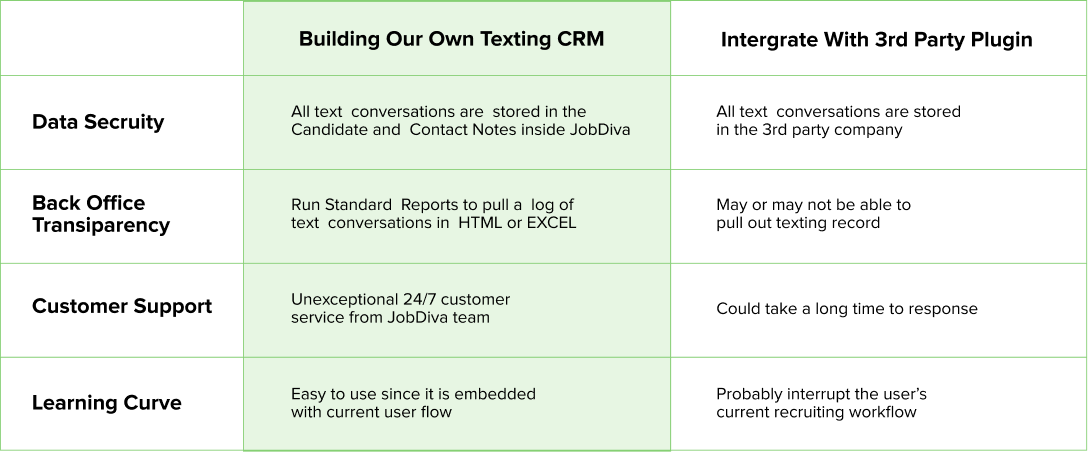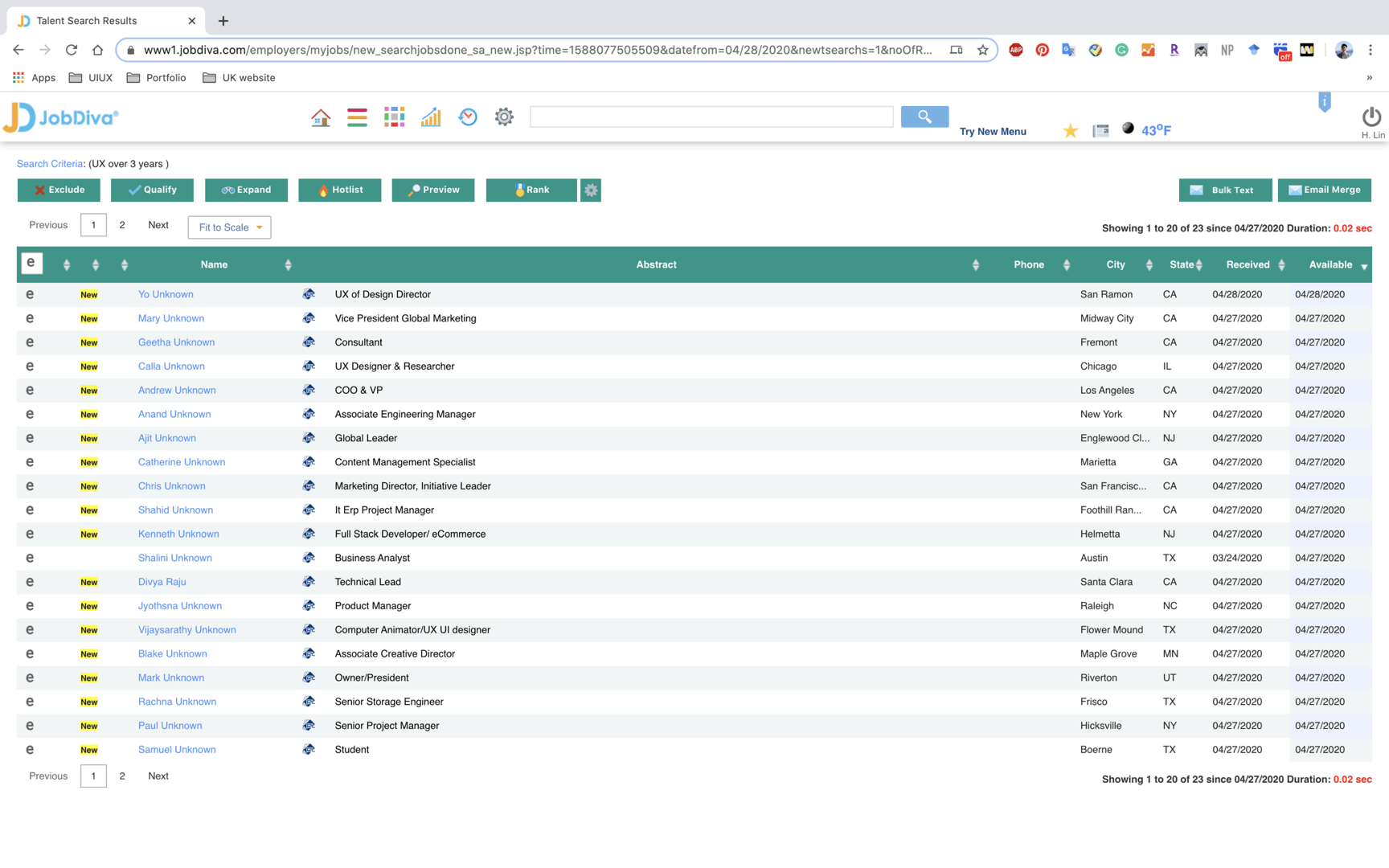Project Overview
This is a professional project I completed when I worked for JobDiva. JobDiva is the leading global Applicant Tracking System and provides the SAAS platform for Talent Acquisition solution. The plan for this project is to create a better CRM for recruiters to optimize their recruiting process.
Team:
1 Designer (Me!) + 1 PM + 3 Developers + 2QA
My Role:
Product Design, User Research, Product Analysis, Interaction Design, Usability Test
Duration:
12/2017 - 05/2018 (6 months)
Tools:
Sketch, Illustrator, Zeplin
Product Highlight

Establish one-on-one relationships with candidates without interrupting their day

Recruiters can send and receive texts from desktop or mobile

Send bulk texts to mass amounts of candidates or contacts at once with pre-build template

All incoming and outgoing texts are stored in candidates’ records and are easy to access
Project Background
Nowadays, Talent Acquisition Software and Applicant Tracking System (ATS) are widely adopted by staffing agencies to accelerate their recruiting process. For recruiters, after they identify potential candidates, they need to use a customer relationship management (CRM) system to reach out to potential talents for further recruiting process. However, traditional CRM has a very low response rate: 5% for the phone calls and 3% for emails.
In today’s competitive hiring market, finding the matching candidate is not the biggest challenge. However, how to get in touch with these talents as soon as possible and get them responded and engaged throughout the entire hiring process is the real problem for most of staffing agencies.


Here is the JobDiva ERP Process diagram I created
CRM in JobDiva
The graphic on the left represents how JobDiva rationalizes and standardizes the recruiting process from start to finish, to optimize staffing recruiting performance.
CRM is used to connect candidates and clients, which is one of the essential components to serve Candidate Engagement. From past experience, we realize that increasing candidate engagement would significantly help recruiter close deals faster. Thus, developing an advanced CRM is always on JobDiva's top priority.
Our company decided to help our clients (staffing agencies) win the recruiting competition by creating a better CRM.
Design Requirements
Base on the business requirement, the new CRM needs to meet the following requirement:
1. Increase the open rate and response rate from potential candidates.
2. Facilitate the relationship between recruiters and candidates.
3. Seamlessly integrated into the current JobDiva platform.
4. Low learning curve for JobDiva users (staffing recruiters) to use.

Research
Define the Users?
A recruiter finds qualified candidates for a job opening and works to meet the demands of both the employer and the employee throughout the hiring process. The recruiter owns the end-to-end process of talent acquisition. Some of the key responsibilities of the recruiter include:
- Meeting with the hiring manager after the organization opens new job requisition
- Attracting and sourcing candidates, pre-screening and presenting qualified job candidates to the hiring manager
- Serving as the employee brand ambassador, while internally and externally soliciting employee referrals
- Serving as the main point of contact for all parties throughout the collaborative hiring process
- Conducting reference checks and background checks
- Managing the job offer process
- Delivering an exceptional candidate experience
- Participate in employee onboarding to ensure the new hire is prepared to begin work.


I created a visual journey map of the recruiting process. Beginning in step 4, recruiters need to use CRM to contact prospective candidates for different recruiting needs.
Understanding the Recruiting Process
In order to have a better understanding of what role does CRM plays during the staffing recruiting process, I created the journey map of the modern recruiting process. For staffing agencies, after they get the hiring requirement from their client, they need to identify the hiring needs (Step 1), and then use these requirements to search for matching candidates (Step 2) from their company’s resume database to identify viable candidates (Step 3). Beginning in step 4, recruiters need to use CRM to contact prospective candidates for different recruiting needs.
Step 4 is the first time recruiters reach out to candidates. Whether recruiters can continue with the following recruiting steps depends on whether candidates will respond or not at Step 4. Then I decided to put the focus on the 1st time recruiters reaching out to candidates.
Identify the Problem With Current CRM
Recruiters who use JobDiva products usually use phone calls and email to contact candidates. In order to get more insights to learn the reason for the low response rate, I decided to interview both recruiters and job seekers to study their communication experience with our current CRM.

Phone calls and emails are our current CRM
User Interview Insights
Recruiters who use JobDiva products usually use phone calls and email to contact candidates. In order to get more insights to learn the reason for the low response rate, I decided to interview both recruiters and job seekers to learn their communication experience with our current CRM.

Phone calls & emails are not efficient enough to meet recruiters’ needs.
In the increasingly competitive staffing industry, speed matters more than ever. The low open rate of job email and low response rate of current CRM tools slow the recruiting speed.

Majority of candidates want to be contacted on their ground
Candidates are busy with their daily work, hustling from meeting to meeting, or errand to errand. Most of the time, recruiters reach out to them at the wrong time and candidates wish they could be contacted on their ground.
Reason for Low Response Rate
The following images visualize the process when recruiters first time reaching out to potential candidates for the first time using our current CRM (phone calls and emails). I summarized some common road-blockers that caused the low response rate.

This is the flow when recruiters reaching out to candidates with phone calls and emails.
Opportunity
The Power of Texting CRM
After identifying problems with the current CRM and with an understanding of what do recruiters need at different recruiting stages, I then propose the texting CRM for fellowing reasons. Base on the following 2 major advantages of Texting CRM, JobDiva decided to develop its own texting CRM and integrate it into the existing platform.
Text Has Higher Open Rate Than Emails
According to insights from marketing automation provider RedEye, while the average email open rate is between 28% and 33%, the average open rate for a text message is about 99%, with 97% of messages being read within 15 minutes of receipt.
Text Feels Less Harassing Than Phone Calls
Text is a great way to communicate job opportunities with folks who are at work without interrupting their daily work. They can read the message without feeling guilty and respond to it without their colleagues or boss looking over their shoulders.
Design Challenge 1:
Develop Native Texting CRM VS 3rd Party Plugin
There are a bunch of texting tools out in the market, and it is very common for a SaaS platform to integrate with a vast array of external products. We soon ran into the discussion of if we should develop our native texting CRM or integrating with 3rd party plugin? After a lengthy conversation, we made the decision together with the executive team to build our native texting CRM with fellow reasons.
Benefits of building our own texting CRM
We evaluated the benefits and tradeoff of using our native texting CRM solution versus using the third party plugin. The chart on the right shows our detailed consideration of these two different approaches. The primary concern of using a 3rd party plugin is that it may interrupt existing user flow.

Low Cost for Client
Building our own native texting CRM would provide a comparable price for our clients. The table on the right represents a month of texting with JobDiva’s native texting CRM compared to an external provider, assuming you have 10 users sending 10,000 texts per month.

Design Challenge 2:
Integrating with JobDiva Platform
Right after we decided to build our native texting CRM, I started thinking about how to integrate that function with the existing platforms to create a configurable network of solutions that are easily leveraged through a single system of record. I looked back at research and created two design principles to make sure my design decision align with business requirements:

Seamless Integration
Adding new features may affect users' regular user flow. We hope to minimize the side effect by:
- Not make major changes to the current user flow
- Reuse existing components to lower learning curve

Facilitate Engagement
We hope the new CRM can enhance the recruiting efficiency by keeping the candidates engaged during the entire hiring process to help recruiters close deals faster.

Recruiters use CRM for different needs during different recruiting stages. I summarized 3 major needs throughout the entire recruiting workflow, and then added 3 entrances of Texting CRM to JobDiva’s platform to comandante recruiters' various needs:
- Step 4: Needs for efficient communication
- Step 5 - Step 6: Needs for customized communication
- Step 7 - Step 9: Needs for personalized communication
Feature Entrance 1:
Support the need for efficient communication
User Case: Recruiters need to use CRM at step 4 to reach out to a large number of candidates who meet with job requirements to share the job descriptions and learn their availability.
Solution: The 1st entrance is on the talent search result page. In order not to make any significant change to the current recruiting workflow, I added the entry of text CRM next to the entrance of email CRM. Recruiters can use Texting CRM to send bulk text messages to a big list of candidates who meet the job requirement with the prebuilt templates.



Feature Entrance 2:
Support the need for customized communication
User Case: Recruiters need to use CRM at steps 5 and 6 to reach out to an individual candidate to set up phone screening to learn candidates’ background and experience, and communicate the interview time and process if that candidate passed the phone screen.
Solution: The 2nd entrance is on the candidate’s profile page. I added a message icon next to the candidate’s phone number. A message window will pop up if users click the icon. Recruiters can use this entrance to send customized text messages to individual candidates for particular recruiting steps during the middle stages.



Feature Entrance 3:
Support the need for personalized communication
User Case: Recruiters need to use CRM at steps 7, 8, and 9 to reach out to an individual candidate to inform the job offer and negotiate salary, share onboarding necessity and remind them of hiring requirements such as background check.
Solution: The 3rd entrance is on the JobDiva dashboard, which leads to the central location of the Texting CRM, where it keeps a comprehensive record of all text messages that are sent and received. A recruiter can not only see his ongoing-conversation with this candidate. But also have a chance to review all the other recruiters’ previous texting history with this candidate. In this case, he can have a better understanding of these people and generate a more personalized message to this candidate based on the texting history during later stages.



Key Results
50%
99%
97%
response rate from candidates
open rate for outset text
of responses comes within 15 mins
Reflection
Although this project is mainly about designing the software for recruiters, during the process, I have to keep the candidate in mind. And that's one of the essential factors for talent acquisition. The definition of candidate experience is "how candidates feel about the recruiters once they experience the hiring process." Good candidate experience will have a positive influence on candidates' decision to accept the job offer. Having constant communication via text messages will make candidates feel like their time is valued by the recruiting team and hence establish a better relationship between these two stakeholders. In this case, candidates will be more motivated to accept the job offer and help recruiters fill the job vacant.
© Harri Lin 2023